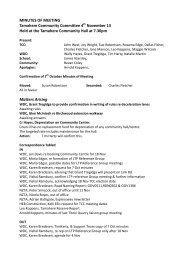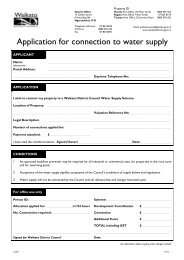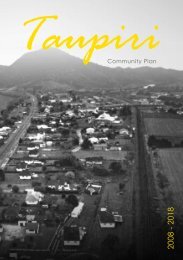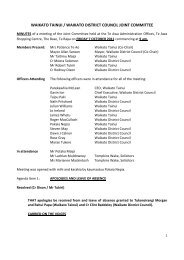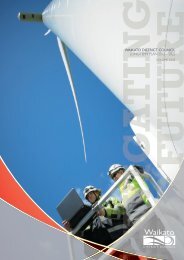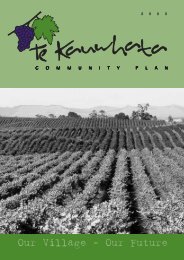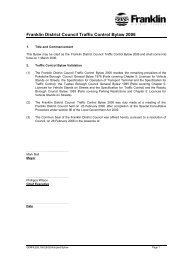1.2 Purpose of this waste assessment - Waikato District Council
1.2 Purpose of this waste assessment - Waikato District Council
1.2 Purpose of this waste assessment - Waikato District Council
- No tags were found...
You also want an ePaper? Increase the reach of your titles
YUMPU automatically turns print PDFs into web optimized ePapers that Google loves.
A.2.2Economic growthEconomic growth has traditionally been correlated with <strong>waste</strong> production. Higher levels <strong>of</strong> economic activityleads to greater production and consumption <strong>of</strong> goods and <strong>this</strong> in turn can lead to higher quantities <strong>of</strong> <strong>waste</strong>.A common measure <strong>of</strong> economic growth is Gross Domestic Product (GDP). With no historical <strong>waste</strong> data, itis not possible to demonstrate a correlation between <strong>waste</strong> volumes and GDP within the district.However analysis <strong>of</strong> data from other parts <strong>of</strong> New Zealand has been analysed in <strong>this</strong> way, and shows a strongcorrelation between <strong>waste</strong> and GDP.In recent time, GDP growth has fallen sharply and at the time <strong>of</strong> writing <strong>this</strong> report NZ had experienced sevenconsecutive quarters <strong>of</strong> negative economic growth. Economic forecasts vary with some predicting an extendedperiod <strong>of</strong> weak growth 18 before the economy recovers to previous historical levels.In terms <strong>of</strong> planning for <strong>waste</strong> facilities and services however it is important to ensure demand is met and so itis prudent to take a more optimistic view. Below are GDP forecasts to 2016 which indicate a return to growth<strong>of</strong> around 3 per cent per annum by 2010.Table 22: GDP and GDP growth to 20162010 2011 2012 2013 2014 2015 2016GDP ($m) 34,140 35,329 36,151 37,248 38,378 39,542 40,439GDP growth 3.42% 3.48% 2.33% 3.03% 3.03% 3.03% 2.27%Source: Goldman Sachs JB WereOn the basis <strong>of</strong> the correlation noted above, the trend in GDP would indicate a reduction in <strong>waste</strong> over thecoming year followed by a return to historical levels <strong>of</strong> <strong>waste</strong> growth.A.2.3Recycling marketsRecovery <strong>of</strong> materials from the <strong>waste</strong> stream for recycling and reuse is heavily dependent on the recoveredmaterials having an economic value. This particularly holds true for recovery <strong>of</strong> materials in the private sector.Markets for recycled commodities are influenced by prevailing economic conditions and most significantly bycommodity prices for the equivalent virgin materials.In the latter part <strong>of</strong> 2008, after the global economic crisis, international markets for recycled commodities fellsharply. Prices for aluminium cans dropped from $1000 a tonne to $100. Plastics, on average, fell from $280a tonne to $200, steel from $700 to $100 and copper from $8000 to $4000. Cardboard and paper pricesalso dropped 90 per cent. 19 Since <strong>this</strong> time demand and prices have recovered to a degree but not to previouslevels. While the fall appears dramatic, prices were falling from record highs and have in real terms simplyreturned to pre-boom prices. This is illustrated in Figure 5.18 http://www.nzherald.co.nz/economy/news/article.cfm?c_id=34&objectid=10580231&pnum=219 http://www.stuff.co.nz/4810576a13.html54



